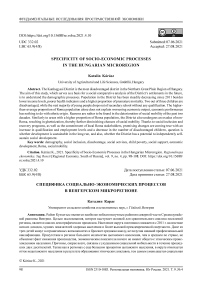Specificity of socio-economic processes in the Hungarian microregion
Автор: Krsz Katalin
Журнал: Региональная экономика. Юг России @re-volsu
Рубрика: Фундаментальные исследования пространственной экономики
Статья в выпуске: 4 т.9, 2021 года.
Бесплатный доступ
The Kunhegyesi District is the most disadvantaged district in the Northern Great Plain Region of Hungary. The aim of this study, which serves as a basis for a social comparative analysis of the District’s settlements in the future, is to understand the demographic processes. Population in the District has been steadily decreasing since 2011 besides lower income levels, poorer health indicators and a higher proportion of premature mortality. Two out of three children are disadvantaged, while the vast majorityof young people drops out of secondaryschool without any qualification. The higher-than-average proportion of Roma population alone does not explain worsening economic output, economic performance has nothing to do with ethnic origin. Reasons are rather to be found in the deterioration of social mobility of the past two decades. Similarly to areas with a higher proportion of Roma population, the District also undergoes an exodus of non- Roma, resulting in ghettoization, thereby further diminishing chances of social mobility. Thanks to social inclusion and recovery programs, as well as the commitment of local Roma stakeholders, promising changes are coming true with an increase in qualification and employment levels and a decrease in the number of disadvantaged children, question is whether development is sustainable in the long run, and also, whether the District has a potential to independently self- sustain social development.
Demography, social inclusion, disadvantage, social services, child poverty, social support, economic development, roma, social mobility
Короткий адрес: https://sciup.org/149139604
IDR: 149139604 | DOI: 10.15688/re.volsu.2021.4.10
Список литературы Specificity of socio-economic processes in the Hungarian microregion
- Bukodi E., Paskov M., Nolan B., 2017. Intergenerational Class Mobility in Europe: A New Account and an Old Story. INET Oxford Working Papers, no. 03. Institute for New Economic Thinking at the Oxford Martin School. URL: https://academic.oup.com/sf/article-abstract/98/3/941/5477829?redirectedFrom= fulltext.
- Domokos V., 2010. Szegény- és cigánytelepek, városi szegregátumok területi elhelyezkedésének és infrastrukturális állapotának elemzése különbözõ közoktatási, egészségügyi, településfejlesztési adatforrások egybevetésével. Budapest, ECOTREND Bt. URL: https://tamogatoweb.hu/index.php/irasaink1/644-szegregaciotol-a-felzarkozasig-ii-resz.
- Enyedi Gy., Tamási P., 2001. Szegénység Magyarországon. INFO-Társadalomtudomány, no. 54, pp. 3-6. URL: http://real-j.mtak.hu/5374/3/InfoTarsadalomtudomany_054.pdf.
- Gonda V.J., Péli L., Nagyné M.M., 2020. Generációváltás problematikája a tanyasi életformában – fiatalok az élet peremén (a) vagy az, elveszett paradicsomban.
- Studia Mundi – Economica, no. 7 (4), pp. 47-59. DOI: 10.18531/Studia.Mundi.2020.07.01.26-36. URL: http://studia.mundi.gtk.szie.hu/generaciovaltasproblematikaja-tanyasi-eletformaban-fiatalok-azelet-peremen-avagy-az-elveszett.
- Harcsa I., 2018. Vita, hozzászólás: Módszertani tanulságok a társadalmi percepciók mérése kapcsán. Reflexiók Huszár Ákos és Záhonyi Márta, A szubjektív mobilitás változása Magyarországon” címû írásához. Demográfia, no. 61 (1), pp. 91-98. DOI: 10.21543/Dem.61.1.4. URL: http://demografia.hu/kiadvanyokonline/index.php/demografia/article/view/2746
- Havasi É., 2015. A magyarországi létminimum-számítás korszakai nemzetközi összehasonlításban. Statisztikai Szemle, 93/10. URL: https://www.ksh.hu/statszemle_archive/2015/2015_10/2015_10_885.pdf.
- Huszár Á., Záhonyi M., 2018. A szubjektív mobilitás változása Magyarországon. Demográfia, no. 61 (1), pp. 5-27. DOI: 10.21543/Dem.61.1.1. URL: http://www.demografia.hu/kiadvanyokonline/index.php/demografia/article/view/2743.
- Idetartozunk Egyesület (We Belong Here Association), 2019. A kezdetek: 2011. Az identitáspolitika. URL: https://idetartozunk.org/kik-vagyunk.
- Jedynak W., Káposzta J., Kinal J. (Szerk.), 2017. Changes As a Social Process. Rzeszów, University of Rzeszów. URL: http://www.kulturawsieci.pl/wp-content/uploads/2017/12/Jedynak-Kaposzta-Kin al-Changes-as-a-social-process.pdf.
- Kirby P., 2006. Vulnerability and Violence: The Impact of Globalisation. Pluto Press, University of Michigan, pp. 130-145.
- Kiss D., Lantos Sz., Marozsán Cs., Németh N., 2013. Jelenlét – A roma integrációt szolgáló fejlesztések megalapozása, szociális munka kirekesztett közösségekben, szegregátumokban. Budapest, Magyar Máltai Szeretetszolgálat. URL: https://jelenlet.maltai.hu/wp-content/uploads/2015/05/Jelenl%c3%a9t-tanulm%c3%a1ny.pdf.
- Molnár M., Bogárdi T., 2016. Investigating Provincial Hungary: Social Recovery or Recession?
- Jedynak W., Kinal J., eds. Society – Modernity – Change: Selected Issues from Central Europe. Krakow, University of Rzeszów, pp. 93-104.
- Matkovich I., 2011. Népszámlálási kampány romákkal – Fontosabb az eredménynél. Magyar Narancs, no. 42 (10.20). URL: https://magyarnarancs.hu/belpol/nepszamlalasi_kampany_romakkal_-_fontosabb_ az_eredmenynel-77142.
- NEKIR, 2019. Népegészségügyi Elemzési Központ Információs Rendszer. Budapest, Nemzeti Népegészségügyi Központ. URL: http://www.jnszm.hu/wp-content/uploads/sites/4/2019/11/45_2019_11_15_kh_mell_egeszseg_2018_tajek.pdf.
- Pénzes J., Tátrai P., Pásztor I., 2018. A roma népesség területi megoszlásának változása Magyarországon az elmúlt évtizedekben. Területi Statisztika, no. 58 (1), pp. 3-26. DOI: 10.15196/TS580101. URL: https://www.ksh.hu/docs/hun/xftp/terstat/2018/01/ts580101.pdf.
- Ritter K., 2014. Possibilities of Local Economic Development (LED) in Lagging Rural Areas. Acta Carolus Robertus, no. 4 (1), pp. 101-108. URL: https://ideas.repec.org/a/ags/hukruc/171185.html.
- Ritter K., 2008. A helyi fejlesztés esélyei – agrárfoglalkoztatási válság és területi egyenlõtlenségek Magyarországon. Területi Statisztika, no. 48 (5), pp. 554-572. URL: https://matarka.hu/cikk_list.php?fusz=39925.
- Ritter K., 2017. Analysis of Local Economic Development Capacity in Hungarian Rural Settlements. Acta Universitatis Sapientiae Economics and Business, no. 5, pp. 57-70. DOI: 10.1515/auseb-2017-0004. URL: https://www.sciendo.com/article/10.1515/auseb-2017-0004.
- Ritter K., 2018. Special Features and Problems of Rural Society in Hungary. Studia Mundi – Economica, no. 1, pp. 98-112. DOI: 10.18531/Studia.Mundi.2018.05.01.98-112. URL: http://studia.mundi.gtk.szie.hu/special-features-and-problems-ruralsociety-hungary.
- Sofovic B., Kragulj J., Pop D., 2012. Preventing the Separation of Children from Their Families in Bosnia and Herzegovina. Raynor C., ed. Review of Hope and Homes for Children ACTIVE Family Support Programme in Bosnia and Herzegovina, 2003–2010. URL: https://www.hopeandhomes.org/wpcontent/uploads/2016/12/BiH-Active-Family-Support-Report_final_LowR.pdf.
- Szur ovec I ., 201 9. Olc sóbb l enne s egíten i a családoknak, mégis inkább elveszik tőlük a gyerekeket. URL: https://index.hu/belfold/2019/05/06/allami_gon dozas_gyerek_kiemeles_tamogatas/.
- TeIR, 2018. URL: https://www.teir.hu/helyzet-ter-kep/kivalasztott-mutatok.html?xteiralk=htk&xids=1057, 1058,1061,1062,1071,1072,1073,1074,1075,1076,1077,1078&xtertip=J&xterkod=164.


